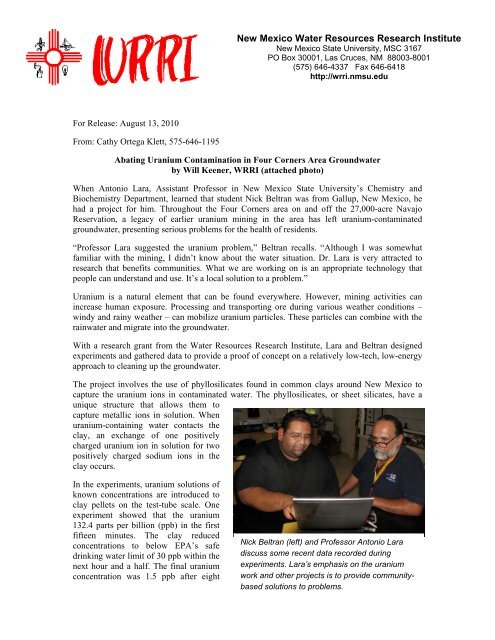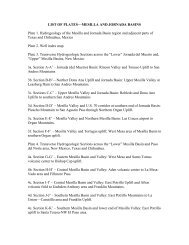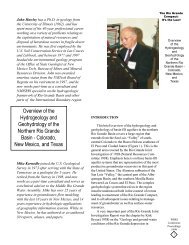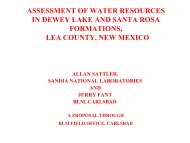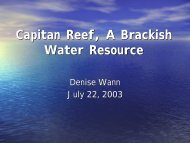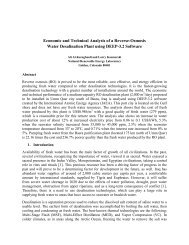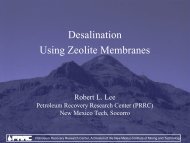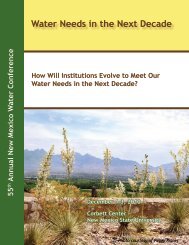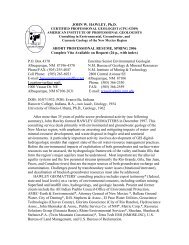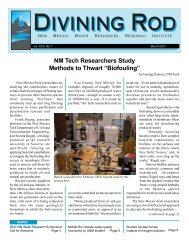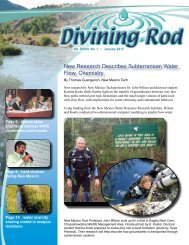Abating Uranium Contamination in Four Corners Area Groundwater
Abating Uranium Contamination in Four Corners Area Groundwater
Abating Uranium Contamination in Four Corners Area Groundwater
You also want an ePaper? Increase the reach of your titles
YUMPU automatically turns print PDFs into web optimized ePapers that Google loves.
New Mexico Water Resources Research Institute<br />
New Mexico State University, MSC 3167<br />
PO Box 30001, Las Cruces, NM 88003-8001<br />
(575) 646-4337 Fax 646-6418<br />
http://wrri.nmsu.edu<br />
For Release: August 13, 2010<br />
From: Cathy Ortega Klett, 575-646-1195<br />
<strong>Abat<strong>in</strong>g</strong> <strong>Uranium</strong> <strong>Contam<strong>in</strong>ation</strong> <strong>in</strong> <strong>Four</strong> <strong>Corners</strong> <strong>Area</strong> <strong>Groundwater</strong><br />
by Will Keener, WRRI (attached photo)<br />
When Antonio Lara, Assistant Professor <strong>in</strong> New Mexico State University’s Chemistry and<br />
Biochemistry Department, learned that student Nick Beltran was from Gallup, New Mexico, he<br />
had a project for him. Throughout the <strong>Four</strong> <strong>Corners</strong> area on and off the 27,000-acre Navajo<br />
Reservation, a legacy of earlier uranium m<strong>in</strong><strong>in</strong>g <strong>in</strong> the area has left uranium-contam<strong>in</strong>ated<br />
groundwater, present<strong>in</strong>g serious problems for the health of residents.<br />
“Professor Lara suggested the uranium problem,” Beltran recalls. “Although I was somewhat<br />
familiar with the m<strong>in</strong><strong>in</strong>g, I didn’t know about the water situation. Dr. Lara is very attracted to<br />
research that benefits communities. What we are work<strong>in</strong>g on is an appropriate technology that<br />
people can understand and use. It’s a local solution to a problem.”<br />
<strong>Uranium</strong> is a natural element that can be found everywhere. However, m<strong>in</strong><strong>in</strong>g activities can<br />
<strong>in</strong>crease human exposure. Process<strong>in</strong>g and transport<strong>in</strong>g ore dur<strong>in</strong>g various weather conditions –<br />
w<strong>in</strong>dy and ra<strong>in</strong>y weather – can mobilize uranium particles. These particles can comb<strong>in</strong>e with the<br />
ra<strong>in</strong>water and migrate <strong>in</strong>to the groundwater.<br />
With a research grant from the Water Resources Research Institute, Lara and Beltran designed<br />
experiments and gathered data to provide a proof of concept on a relatively low-tech, low-energy<br />
approach to clean<strong>in</strong>g up the groundwater.<br />
The project <strong>in</strong>volves the use of phyllosilicates found <strong>in</strong> common clays around New Mexico to<br />
capture the uranium ions <strong>in</strong> contam<strong>in</strong>ated water. The phyllosilicates, or sheet silicates, have a<br />
unique structure that allows them to<br />
capture metallic ions <strong>in</strong> solution. When<br />
uranium-conta<strong>in</strong><strong>in</strong>g water contacts the<br />
clay, an exchange of one positively<br />
charged uranium ion <strong>in</strong> solution for two<br />
positively charged sodium ions <strong>in</strong> the<br />
clay occurs.<br />
In the experiments, uranium solutions of<br />
known concentrations are <strong>in</strong>troduced to<br />
clay pellets on the test-tube scale. One<br />
experiment showed that the uranium<br />
132.4 parts per billion (ppb) <strong>in</strong> the first<br />
fifteen m<strong>in</strong>utes. The clay reduced<br />
concentrations to below EPA’s safe<br />
dr<strong>in</strong>k<strong>in</strong>g water limit of 30 ppb with<strong>in</strong> the<br />
next hour and a half. The f<strong>in</strong>al uranium<br />
concentration was 1.5 ppb after eight<br />
Nick Beltran (left) and Professor Antonio Lara<br />
discuss some recent data recorded dur<strong>in</strong>g<br />
experiments. Lara’s emphasis on the uranium<br />
work and other projects is to provide communitybased<br />
solutions to problems.
hours of exposure to the layered phyllosilicates.<br />
“It takes some time to get to that po<strong>in</strong>t, and that’s one of the th<strong>in</strong>gs we’re still address<strong>in</strong>g,” says<br />
Beltran. “But the process is very simplistic, with low energy requirements.”<br />
The research team is us<strong>in</strong>g two key tools to study the uranium abatement process and f<strong>in</strong>d<br />
opportunities to optimize it. The <strong>in</strong>ductively coupled plasma mass spectrometer can determ<strong>in</strong>e the<br />
presence of uranium isotopes at the parts per billion level, Beltran expla<strong>in</strong>s. It takes an accurate<br />
snapshot of the water sample at a po<strong>in</strong>t <strong>in</strong> time. Another <strong>in</strong>strument, the lum<strong>in</strong>escent<br />
spectrometer, can track changes over time, although only <strong>in</strong> the parts per million concentration<br />
range.<br />
“As the abatement takes place, we can see the charged uranium quickly concentrates around the<br />
sorbent (clay particles), but the ion exchange moves slower,” says Beltran.<br />
The researchers are test<strong>in</strong>g different clays as opportunities arise, but so far the type of clay hasn’t<br />
mattered. “We see brown clays from near Ber<strong>in</strong>o and red clays from around Gallup, but the<br />
structures are similar and both seem to work equally well,” says Beltran.<br />
Team members are study<strong>in</strong>g water pH, uranium concentrations, exposure times to the clay, and<br />
other variables <strong>in</strong> bench-scale tests to better understand the process. Right now, the team<br />
describes the uptake of uranium by the clay as “sorb<strong>in</strong>g.” This is a term that describes potential<br />
mechanisms that may be at work – adsorption or absorption, says Beltran. “The next step is to do<br />
k<strong>in</strong>etic and thermodynamic studies to determ<strong>in</strong>e what actually goes on <strong>in</strong>side the clay and then<br />
propose models that will improve the sorption design.”<br />
“The use of clay to abate uranium is only one potential application,” Lara expla<strong>in</strong>s. “We will be<br />
work<strong>in</strong>g with one element at a time, but there is no reason to have heavy metals <strong>in</strong> dr<strong>in</strong>k<strong>in</strong>g water<br />
with this approach. It’s an appropriate level of technology.” Lara has reached out to affected<br />
communities by establish<strong>in</strong>g a relationship with researchers at D<strong>in</strong>è Community College at<br />
Shiprock, New Mexico. When D<strong>in</strong>è Environmental Institute Director Marnie Carrol and a D<strong>in</strong>è<br />
College student arrive on the NMSU campus <strong>in</strong> late July, Lara, Beltran and the team will work<br />
with them to help analyze soil and water samples collected on the Navajo Reservation. This<br />
outreach is critical, says Beltran. The problem threatens to become worse, as attention on U.S.<br />
uranium supplies becomes more <strong>in</strong>tense and m<strong>in</strong><strong>in</strong>g companies aga<strong>in</strong> eye potential m<strong>in</strong><strong>in</strong>g sites <strong>in</strong><br />
the <strong>Four</strong> <strong>Corners</strong> region.<br />
By prov<strong>in</strong>g that the concept works and demonstrat<strong>in</strong>g it at a community scale, Beltran is hopeful<br />
that m<strong>in</strong><strong>in</strong>g companies as well as local governments will adopt the process.<br />
Members of the research team have <strong>in</strong>cluded several NMSU undergraduates: Jesus Mart<strong>in</strong>ez,<br />
biology; Raymundo Chavira, genetics; Vanessa Begay, biology; Amanda Munoz, biochemistry;<br />
David Kimball, biology; William Bradley, chemical eng<strong>in</strong>eer<strong>in</strong>g; Rich Eriacho, chemistry; and<br />
Diane Shelby, animal and range science.<br />
Most of the team members have become <strong>in</strong>volved <strong>in</strong> the uranium project through the Bridge<br />
Program, which promotes the education of Native American students <strong>in</strong> biomedical research, and<br />
the NMSU RISE to Excellence Program. RISE encourages m<strong>in</strong>orities and other selected groups<br />
to participate <strong>in</strong> a research career.<br />
-------------------------------------------------------------------------------------------------------------------<br />
The New Mexico Water Resources Research Institute is a nonprofit organization that funds<br />
water-related projects at all of New Mexico’s universities.


